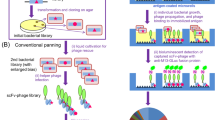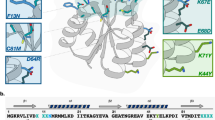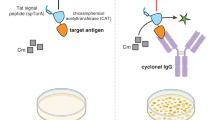Abstract
The efficiency of both phage display in Escherichia coli and periplasmic expression of recombinant proteins may be limited by the same periplasmic folding steps. To search for E. coli factors that improve the efficiency of both procedures, a library of E. coli proteins was coexpressed in a phagemid vector that contained a poorly folding single-chain Fv antibody (scFv) fragment fused to g3p. We enriched, by panning for antigen binding, those phagemids in which the amount of displayed scFv is highest. We thus identified the periplasmic protein Skp/OmpH/HlpA as improving phage display of a wide range of scFv fragments. This occurs as a result of an increase in the amount of hybrid protein displayed on the phage. Coexpression of skp also increases the functional yield of scFv fragments when expressed by secretion to the periplasm.
This is a preview of subscription content, access via your institution
Access options
Subscribe to this journal
Receive 12 print issues and online access
$209.00 per year
only $17.42 per issue
Buy this article
- Purchase on Springer Link
- Instant access to full article PDF
Prices may be subject to local taxes which are calculated during checkout
Similar content being viewed by others
References
Bardwell, J.C. 1994. Building bridges: disulphide bond formation in the cell. Mol. Microbiol. 14: 199–205.
Makrides, S.C. 1996. Strategies for achieving high-level expression of genes in Escherichia coli . Microbiol. Rev 60: 512–538.
Martin, J. and Hartl, F.U. 1997. Chaperone-assisted protein folding. Curr. Opin. Struct. Biol. 7: 41–52.
Buchner, J. 1996. Supervising the fold: functional principles of molecular chaper-ones. FASEB J. 10: 10–19.
Wall, J.G., Plückthun, A. 1995. Effects of overexpressing folding modulators on the in vivo folding of heterologous proteins in Escherichia coli . Curr. Opin. Biotechnol. 6: 507–516.
Missiakas, D., Betton, J.M., and Raina, S. 1996. New components of protein folding in extracytoplasmic compartments of Escherichia coli SurA, FkpA and Skp/OmpH. Mol. Microbiol. 21: 871–884.
Pogliano, J., Lynch, A.S., Belin, D., Lin, E.C.C., and Beckwith, J. 1997. Regulation of Escherichia coli cell envelope proteins involved in protein folding and degradation by the Cpx two-component system. Genes Dev. 11: 1169–1182.
Danese, P.N. and Silhavy, T.J. 1997. The σE and the Cpx signal transduction systems control the synthesis of periplasmic protein-folding enzymes in Escherichia coli . Genes Dev. 11: 1183–1193.
De Las Peñas, A., Connolly, L., and Gross, C.A. 1997. The σE-mediated response to extracytoplasmic stress in Escherichia coli is transduced by RseA and RseB, two negative regulators of σE . Mol. Microbiol. 24: 373–385.
Missiakas, D., Mayer, M.P., Lemaire, M., Georgopoulos, G., and Raina, S. 1997. Modulation of the Escherichia coli σE (RpoE) heat-shock transcription-factor activity by the RseA, RseB and RseC proteins. Mol. Microbiol. 24: 355–371.
Smith, G.P. 1985. Filamentous fusion phage: Novel expression vectors that display cloned antigens on the virion surface. Science 228: 1315–1317.
Dunn, I.S. 1996. Phage display of proteins. Curr. Opin. Biotechnol. 7: 547–553.
Bedzyk, W.D., Weidner, K.M., Denzin, L.K., Johnson, L.S., Hardman, K.D., Pantoliano, M.W., et al. 1990. Immunological and structural characterization of a high affinity anti-fluorescein single-chain antibody. J. Biol. Chem. 265: 18615–18620.
Whitlow, M., Howard, A.J., Wood, J.F., Voss, E.W. Jr., and Hardman, K.D. 1995. 1.85 Å structure of anti-fluorescein 4-4-20 Fab. Protein Eng. 8: 749–761.
Nieba, L., Honegger, A., Krebber, C., and Plückthun, A. 1997. Disrupting the hydrophobic patches at the antibody variable/constant interface: improved in vivo folding and physical characterization of an engineered scFv fragment. Protein Eng. 10: 435–444.
Chen, R. and Henning, U. 1996. A periplasmic protein (Skp) of Escherichia coli selectively binds a class of outer membrane proteins. Mol. Microbiol. 19: 1287–1294.
Krebber, A., Bornhauser, S., Burmester, J., Honegger, A., Willuda, J., Bosshard, H.R., and Plückthun, A. 1997. Reliable cloning of functional antibody variable domains from hybridomas and spleen cell repertoires employing a reengineered phage display system. J. Immunol. Methods 201: 35–55.
Holck, A. and Kleppe, K. 1988. Cloning and sequencing of the gene for the DNA-binding 17K protein of Escherichia coli . Gene 67: 117–124.
Tesar, M., Beckmann, C., Roettgen, P., Haase, B., Faude, U., and Timmis, K.N. 1995. Monoclonal antibody against pIII of filamentous phage: an immunological tool to study pIII fusion protein expression in phage display systems. Immunotechnology 1: 53–64.
Knappik, A. and Plückthun, A. 1995. Engineered turns of a recombinant antibody improve its in vivo folding. Protein Eng. 8: 81–89.
Vaughan, T.J., Williams, A.J., Pritchard, K., Osborn, J.K., Pope, A.R., Earnshaw, J.C., et al. 1996. Human antibodies with sub-nanomolar affinities isolated from a large non-immunized phage display library. Bio/technology 14: 309–314.
Krebber, C., Spada, S., Desplancq, D., Krebber, A., Ge, L. and Plückthun, A. 1997. Selectively-infective phage (SIP): a mechanistic dissection of a novel in vivo selection for protein-ligand interactions. J, Mol. Biol. 268: 607–618.
Proba, K., Wörn, A., Honegger, A., and Plückthun, A. 1998. Antibody fragments without disulfide bonds, made by molecular evolution. J. Mol. Biol. 275: 245–253.
Proba, K., Honegger, A. and Plückthun, A. 1997. A natural antibody missing a cysteine in VH: consequences for thermodynamic stability and folding. J. Mol. Biol. 265: 161–172.
Jung, S. and Plückthun, A. 1997. Improving in vivo folding and stability of a single-chain Fv antibody by loop grafting. Protein Eng. 10: 959–966.
Holck, A., Lossius, I., Aasland, R., and Kleppe, K. 1987. Purification and characterization of the 17 K protein, a DNA-binding protein from Escherichia coli . Biochim. Biophys. Acta 914: 49–54.
Hirvas, L., Coleman, J., Koski, P. and Vaara, M. 1990. Bacterial “histone-like protein I” (HLP-I) is an outer membrane constituent? FEBS Lett. 262: 123–126.
Koski, P., Hirvas, L., and Vaara, M. 1990. Complete sequence of the ompH gene encoding the 16-kDa cationic outer membrane protein of Salmonella typhimurium . Gene 88: 117–120.
Koski, P., Rhen, M., Kantele, J., and Vaara, M. 1989. Isolation, cloning, and primary structure of a cationic 16-kDa outer membrane protein of Salmonella typhimurium . J. Biol. Chem. 264: 18973–18980.
Hirvas, L., Koski, P., and Vaara, M. 1991. The ompH gene of Yersinia enterocolitica: cloning, sequencing, expression, and comparison with known enterobacterial ompH sequences. J. Bacteriol. 173: 1223–1229.
Vuorio, R., Hirvas, L., and Raybourne, R.B., Yu, D.T., and Vaara, M. 1991. The nucleotide and deduced amino acid sequence of the cationic 19 kDa outer membrane protein OmpH of Yersinia pseudotuberculosis . Biochim. Biophys. Acta 1129: 124–126.
Fleischmann, R.D., Adams, M.D., White, O., Clayton, R.A., Kirkness, E.F., Kerlavage, A.R., et al. 1995. Whole-genome random sequencing and assembly of Haemophilus influenzae Rd. Science 269: 496–512.
Delamarche, C., Manoha, F., Behar, G., Houlgatte, R., Hellman, U., and Wroblewski, H. 1995. Characterization of the Pasteurella multocida skp and firA genes. Gene 161: 39–43.
Thome, B.M., Hoffschulte, H.K., Schiltz, E., and Müller, M. 1990. A protein with sequence identity to Skp (FirA) supports protein translocation into plasma membrane vesicles of Escherichia coli . FEBS Lett. 269: 113–116.
Thome, B.M. and Müller, M. 1991. Skp is a periplasmic Escherichia coli protein requiring SecA and SecY for export. Mol. Microbiol. 5: 2815–2821.
Raetz, C.R.H. 1996. Bacterial lipopolysaccharides: A remarkable family of bioactive macroamphiphiles, 1035–1063 in Escherichia coli and Salmonella. Curtiss, R., Ingraham, J.L., Lin, E.C.C., Low, K.B., Magasanik, B., Reznikoff, W.S., et al. (eds.). ASM Press, Washington, DC.
Geyer, R., Galanos, C., Westphal, O., and Golecki, J.R. 1979. A lipopolysaccha-ride-binding cell-surface protein from Salmonella minnesota. Isolation, partial characterization and occurrence in different Enterobacteriaceae. Eur. J. Biochem. 98: 27–38.
Aasland, R., Coleman, J., Holck, A.L., Smith, C.L., Raetz, C.R., and Kleppe, K. 1988. Identity of the 17-kilodalton protein, a DNA-binding protein from Escherichia coli, and the firA gene product. J. Bacteriol. 170: 5916–5918.
Sambrook, J., Fritsch, E.F., and Maniatis, T. 1989. Molecular cloning: a laboratory manual. Cold Spring Harbor Laboratory Press, Cold Spring Harbor, NY.
Smith, G.P. and Scott, J.K. 1993. Libraries of peptides and proteins displayed on filamentous phage. Methods Enzymol. 217: 228–257.
Day, L.A. 1969. Conformations of single-stranded DNA and coat protein in fd bacteriophage as revealed by ultraviolet absorption spectroscopy. J. Mol. Biol, 39: 265–277.
Munro, S. and Pelham, H.R. 1986. An Hsp70-like protein in the ER: Identity with the 78 kd glucose-regulated protein and immunoglobulin heavy chain binding protein. Cell 46: 291–300.
Skerra, A. and Plückthun, A. 1988. Assembly of a functional immunoglobulin Fv fragment in Escherichia coli. Science 240: 1038–1041.
Gill, S.C. and von Hippel, P.H. 1989. Calculation of protein extinction coefficients from amino acid sequence data. Anal. Biochem. 182: 319–326.
Reese, M.G. 1994. Diploma Thesis, German Cancer Research Center, Heidelberg, Germany.
Author information
Authors and Affiliations
Rights and permissions
About this article
Cite this article
Bothmann, H., Plückthun, A. Selection for a periplasmic factor improving phage display and functional periplasmic expression. Nat Biotechnol 16, 376–380 (1998). https://doi.org/10.1038/nbt0498-376
Received:
Accepted:
Issue Date:
DOI: https://doi.org/10.1038/nbt0498-376
This article is cited by
-
Domain-level epitope mapping of polyclonal antibodies against HER-1 and HER-2 receptors using phage display technology
Scientific Reports (2022)
-
Application of Genetic Engineering in Biotherapeutics Development
Journal of Pharmaceutical Innovation (2020)
-
Protein folding in the cell envelope of Escherichia coli
Nature Microbiology (2016)
-
Optimization of the secretion pathway for heterologous proteins in Bacillus subtilis
Biotechnology and Bioprocess Engineering (2015)
-
Substrate oscillations boost recombinant protein release from Escherichia coli
Bioprocess and Biosystems Engineering (2014)



